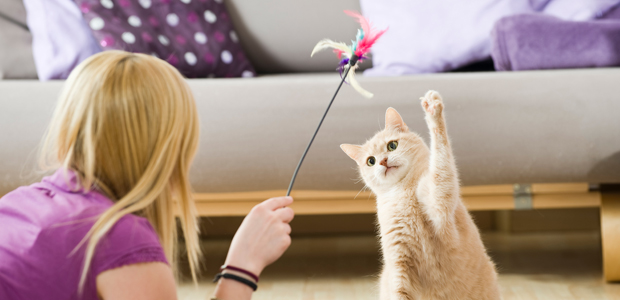How to play with a cat
Cats love to interact with their environment and despite their aloof reputation, they love to play and bond with their owners.
Playing is an essential part of a kitten’s development and cats will enjoy playing even as they mature
What's the best way to play with your cat?
The first thing to consider when asking yourself how to play with a cat is how much mental and physical stimulation your cat has as they go about their day. Cats that have free access to the outdoors will spend their days climbing trees, stalking prey and exploring the great outdoors. Naturally, housecats will need more stimulation than cats that are free to roam.
Your cat will give you clues about their motivation to play, how receptive they are to play and which type of play they enjoy. Look out for signs such as loud meowing, quick movements and spontaneous play.

High motivation to play vs low motivation to play
Every cat is different, so finding out your cat's motivation to play will help you figure out the best way to play with your cat.
Cats with a high motivation to play will be receptive to play at any time of the day and they will rarely tire. They aren’t precious about which toys they play with and they will respond to ‘conditioned stimulus’, so for example they will perk up when a draw containing toys is opened.
Cats with a low motivation to play are the opposite. They will only play with certain toys, at a certain time of day and they will quickly tire of play.
Toys to play with
Finding out what toys your cat likes to play with can take a bit of experimenting.
Cats exercise their predatory instincts when they play, so games that include pouncing, chasing, searching, stalking and manipulating are perfect for engaging their body and minds.
Toys that appeal to these instincts and stimulate your cat's senses should go down well. Objects that are stuffed or rubbed with catnip tend to be a hit with cats. Catnip contains a chemical that gives cats a sense of euphoria.

Toys that move erratically and resemble wild prey, such as feathers and toys with tails, are also popular with cats. The erratic movements will stimulate your cat’s instinct to pounce.
Different textures may also attract your cat to a particular plaything. They often enjoy raking their claws and experiencing the touch of different fabrics.
Toys that “jingle” and have bells on can stimulate a cat’s hearing, although this can alarm more skittish cats.
Objects such as cardboard boxes, split-level platforms and even wardrobes can fulfil a cat’s exploratory urges and can provide them with hours of fun.
Shop now: Toys for cats
Playing with more than one cat
If you’ve got more than one cat in your household, playtime can be complicated. Cat’s can often engage in conflict, and if this happens during play then they can start to associate playing with conflict, which will make them stressed rather than relaxed.
To make sure that your cats don’t engage in conflict, keep an eye on them whilst they are playing. Lookout for tell-tale signs, such as prolonged eye contact, and set up a separate time-out space for each cat. Try and schedule some individual playtime with each of your cats.
Need more cat advice?
If you’d like further info on cat care, speak to your vet. They can provide advice for your specific pet and situation. Find your nearest vet using our Find a Vet page.

